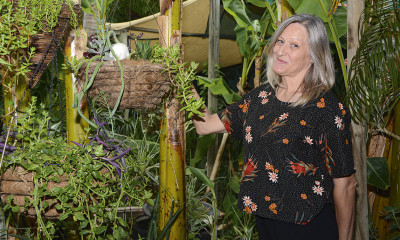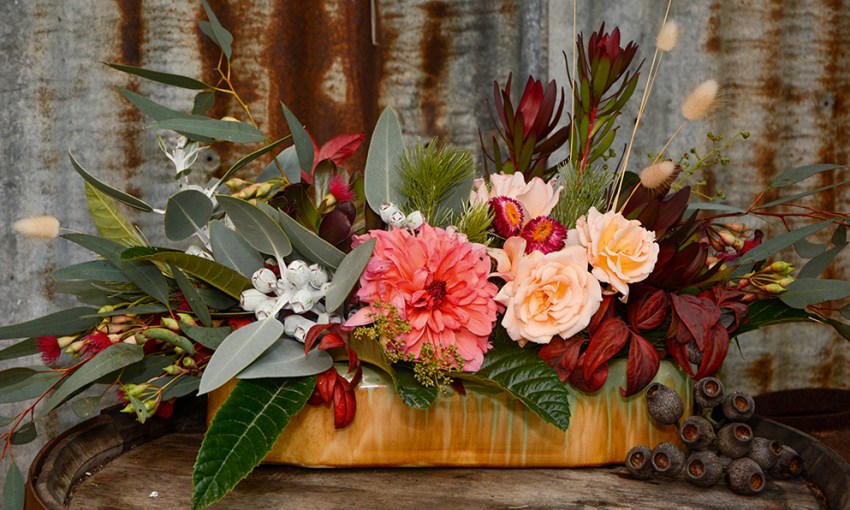The home garden is an oasis of beautiful plants, ready to be foraged and transformed into stunning arrangements to brighten up any room. Here’s how to get started.
In the garden: Make your own foraged arrangement

Kathy Pollard walks through her West Croydon garden, taking a snip from plants here and there. On their own, the cuttings don’t seem all that special to the untrained eye. That is, until Kathy begins to work her magic.
Today’s arrangement is all about using things found in the back yard and throughout the community, with an emphasis on reusing and reducing. Kathy has set up a couple of layers of chicken wire in a vintage pot, found at an op shop. She says there’s no need to go out and buy expensive vases for floristry projects, anything from a teacup to a jar is perfect.
Flowers have always been a passion for Kathy, a florist, floristry teacher at TAFE SA and all-round nature-lover. She remembers making posies with her grandmother for her community church. The flowers were always found in her grandmother’s sprawling garden.
“She knew all her neighbours, they would trade products and were very giving to one another,” Kathy says. “Backyard garden foraging is the most satisfying hobby. If you don’t have a yard, you should at least have indoor pot plants to improve both health and mood.”
Kathy says that while people are social distancing or in isolation, they’re likely to be out in their gardens a lot more – the perfect time to ask if you can forage on the verge side of their fence. “A lovely development of these fraught times is the growth of kindness amongst people. It’s always worth a try!”
It’s easy to have some of your arrangement ready to go, with natives easy to dry, so they are ready for re-use with fresh foliage. Today, Kathy has mixed some dried pieces with the stars of the show. When arranging flowers, she says to think first about a focal piece of the arrangement and work back from there, selecting a variety of greenery.
Pretty much anything in the garden can be used – don’t ignore that gum tree or your woolly busy, they make the perfect green base against some more colourful finds. Kathy suggests cutting a stem and leaving it in a vase for a few days to test a plant’s staying power, and don’t forget to search online to find out if a plant has high toxicity levels. Work with contrasts in leaf and flower sizes and mix your textures.
“Just a few flowers in your house makes such a big difference; nature has the greatest positive impact on our souls. The bright side of staying home is that it gives you time to learn what and who is important to you.
“Backyard foraging is the most satisfying hobby – what better way to occupy your mind with moments of calm and connection in a time that can generate a larger than usual degree of stress?”

Try it yourself
Create your own low, unstructured vintage-inspired design with Kathy’s tips.
Required equipment
Vintage or recycled vessel, such as a trough or urn
Piece of flexible chicken wire
1-3 focal flowers and/or foliage (large and bright)
Mixture of foraged flowers and/or foliage
Prepare the vessel
Scrunch and bend the chicken wire to fit inside, just lower than the vessel level. It should feel firm inside the vessel without space to move around. Fill with clean, fresh water to just below the rim.
Clean and cut stems
Remove any greenery that would be below the water level and cut stems on a 45-degree angle with sharp florists’ scissors. Strong, sharp household scissors or secateurs will do the job. The angle allows more water uptake.
Base
Contrast the colour, size and shape of the foliage you use. Have a strong group of the same variety on one side and one stem on the other side of the arrangement to create visual balance. Add a few longer hanging stems such as the flowering blue gum to create a relaxed and natural feel. I’ve used woolly bush, Eucalyptus tetragona, flowering blue gum, Nandina and large loquat leaves.
Focals
These are the large, eye-catching products. Place them to sit on the foliage base in a low frontal position. Group focal products or use singularly if they’re large enough. I’ve used dahlia and roses.
Height
Tall stems, small heads or light product works well for the height. Three levels work well in their group, with a couple of singular stems on the other side. The height rule is one and a half times the longest part of the container. I’ve used leucadendron and
bunny tails.
Fillers
Fill areas with small materials where more interest is needed. I’ve used parsley seed heads.
Finish
Make sure the chicken wire is covered and introduce low levels to create depth, interest and coverage. I’ve used gum nuts.
Tips
Add a drop of household bleach to the water to curb bacteria and change water every few days.
Ensure each stem is in water so they can drink freely, giving them lasting power.
Position arrangement away from direct sun and draughts.
Remove any dying materials without delay as they create ethylene gas, speeding up the ageing process for the remaining plants.
This article first appeared in the May 2020 issue of SALIFE magazine.



